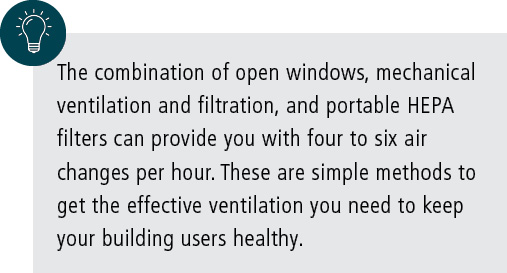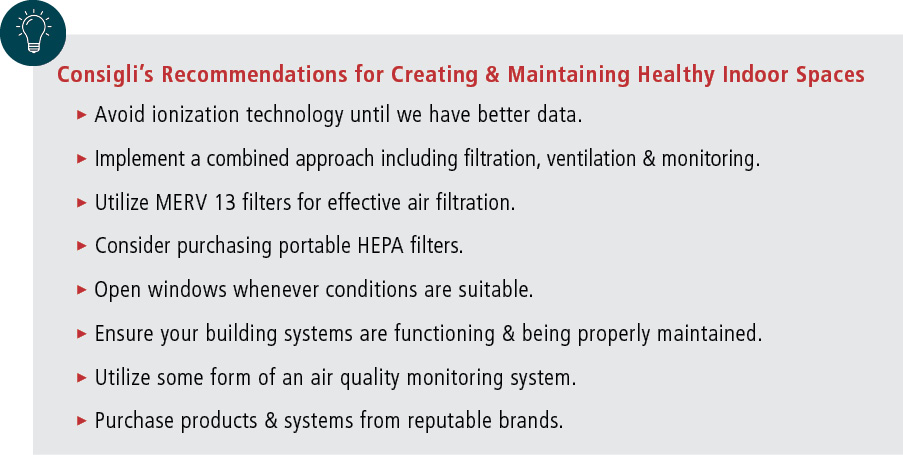Written By: Steven Burke, LEED & WELL Faculty, Director of Sustainability
The global Coronavirus pandemic has undoubtedly caused us to rethink indoor environments. At this point, the average person understands that viral transmission happens through breathing contaminated indoor air. And if they’re spending a significant amount of time indoors, they probably have some questions.
As we prepare for re-entry into our buildings at pre-pandemic capacity and use, people want to know what has been (or is actively being) done to make their space healthy and safe. Many building owners have already made investments, while many are still weighing which measures to take to ensure occupants feel comfortable.
As building owners are navigating their options, let me help clear the air: there are some good ways to spend money to accomplish these healthy and safe indoor spaces, and some ways where the value is in question.
Let’s start with where there is still debate: Ionization Technologies
Many building owners have likely already put money into these systems, and we are currently installing them on some of our projects. And, it’s completely understandable as to why.
The marketing behind these products is compelling: install a device at reasonable marginal cost, flip a switch, and get instant air purification removing viruses, bacteria, and other unwanted contaminants. Applicable in both new construction and existing buildings. Allows for cleaner air without the same energy penalty of increased outdoor air introduction. Win-win-win, right?
However, as much as we really want these devices to be the perfect solution (and maybe someday they will be), we are currently seeing a variety of sources questioning the effectiveness of electronic air purification applications. Some of the biggest issues with these technologies claimed by their opponents include:
- Lack of endorsement by the EPA, CDC, or ASHRAE as effective;
- Lack of independent, third-party verification from groups like Underwriters Laboratories (UL) that these devices do not produce ozone or other harmful byproducts;
- Lack of verification that these devices are as effective in the field as they are in the lab;
- Lack of peer-reviewed research studies; lack of understanding of the long-term system performance and impacts to the indoor environment.
The airplane manufacturer Boeing just released a 20-page report evaluating the effectiveness of ionization technologies tested in an airplane environment. The results? Ionization was proven to be not effective, didn’t meet manufacturers’ claims, and produced unwanted ozone. This open letter from health and building industry professionals also advocates against the adoption of the technology until we have more information. This letter was written specifically to caution school districts from using any of the $176 Billion of COVID relief funds for K-12 schools on what they describe as unproven and potentially harmful technology. The Education Department is even currently drafting new guidance on these “electronic air cleaning devices that are scientifically unproven and could produce harmful chemical byproducts.”
Ultimately, we want ionization technologies to be a go-to solution, and we will continue to monitor the research and progress in this space. But, for the moment, we recommend staying away from them—especially because there are other solutions that we know work well.
As a side note, if you have concerns about electronic air purification, almost all air purifiers you can buy off the internet will come with this technology installed, oftentimes disguised under some proprietary marketing name. If you’re going to buy an air purifier, make sure you’re purchasing one that does the cleaning just by passing through a HEPA filter, and not additional technologies if you don’t want the ionization component.
Here’s what we can recommend: Filtration, Ventilation & Monitoring
Filtration
In the summer of 2020, ASHRAE released a review of how efficient air filters are at capturing viruses, and how much they decrease air flow pressure downstream of the filter. What did they find? MERV 13 filters (MERV = minimum efficiency rating values for air filters) are incredibly effective—89% on average for a single passthrough—at filtering particles down to 0.3 microns. That’s very close to the effectiveness of an N95 mask. Virus particles go down to .1 microns or slightly smaller, but they hitch rides on larger particles that get snagged by filtration equipment. So, making sure you have good filtration is not only very important, but also very effective, both from a cost and efficiency point of view.
And, what about the dreaded “pressure drop” of suppressing downstream airflow when passing it through a thicker filter media? The ASHRAE study showed an average pressure drop at MERV 13 comparable to lower MERV-rated air filters, which don’t have the same efficiency at viral capture. So, perhaps we should look at the viability of upgrading to MERV 13 in existing buildings more closely.
As an added precaution (especially in classrooms or office spaces), you can purchase a portable HEPA filter. It is important to note that when purchasing a HEPA filter, you have to pay attention to the CADR (Clean Air Delivery Rate); use that value and add it to the air change calculations.
Ventilation
Here’s a fun fact: ASHRAE, the industry group responsible for setting ventilation standards, created their threshold for “acceptable” indoor air quality based on the amount of ventilation air needed to control for body odors. Essentially, how much air would you need so that you don’t smell your co-worker?

That, unsurprisingly, does not necessarily equal a healthy indoor air environment. And, while increasing the amount of outdoor air introduced into a space might mean additional energy is used, in new construction, the Passive House model of continuous, balanced ventilation circulating through an energy recovery system allows us to have the best of both worlds: energy efficiency and healthy indoor air quality.
Retrofitting an energy recovery system into an existing building can be much more challenging than new construction. The solutions in retrofits, even in climates with large seasonal swings, may still present many opportunities throughout the year where additional ventilation can be brought into the building without extensive energy penalties (at night, during shoulder seasons, etc.).
In March of 2021, the World Health Organization released a report, “Roadmap to improve and ensure good indoor ventilation in the context of COVID-19” that may be helpful. Individual building strategies on ventilation air may vary slightly whether the overall goal is general healthy indoor air quality versus infection control, but many of the concepts will have overlap.
Monitoring
Monitoring can fall into two related buckets: the monitoring of your systems and maintenance schedules to ensure building systems are operating as expected, and monitoring indoor conditions with an indoor air quality sensor.

When it comes to monitoring your building systems and maintenance schedules, this is absolutely critical and should be priority #1. Making sure outdoor air dampers are properly functioning, air filters are being replaced according to schedule, and systems are not malfunctioning in a way that would compromise indoor air quality are the lowest hanging fruit there is. Even the best designed system can deliver poor indoor air quality if it isn’t functioning properly.
For air quality monitoring, there is a certification program called RESET which focuses exclusively on indoor air quality (and was around pre-COVID), which can be helpful for guidance and how to deploy monitoring. They also have approved hardware lists that anyone can view. These devices do not need to be integrated into the building management system (BMS) to still provide a tremendous amount of value, and even devices that are as cheap as $150 can monitor temperature, relative humidity, carbon dioxide, particulate matter, and volatile organic compounds in the air with a great deal of accuracy.

Other Thoughts
If you want to get your entire space certified as healthy or safe in some capacity, there are programs out there. The WELL Building standard has created the WELL Health-Safety Rating; Fitwel has created a Viral Response Module; and UL is offering a Verified Healthy Building, program to name a few.
In areas that are high risk and/or difficult to retrofit, distributed air purification devices can be a simple solution to consider. If you are going to go with air purification and monitoring devices, make sure that you buy from reputable brands that are likely to be around in five years. Otherwise, you might get stuck with purification devices for which you cannot find replacement filters, or air monitoring devices with software that is no longer functional. And again, take care to ensure that the air purification device does not contain ionization technology.
The options are seemingly endless as more and more companies are jumping on the ionization technology buzzword train. With the world re-opening and people going back to their pre-pandemic routines, let’s keep it simple—make sure your building systems are monitored and operating properly; open windows whenever conditions are suitable; and use MERV 13 filters.
Steven Burke, LEED & WELL Faculty, Director of Sustainability
As one of only two professionals to hold Certified Passive House Consultant (CPHC), LEED and WELL Faculty designations, Steven spearheads Consigli’s sustainability programs at the corporate, departmental and project levels. He is responsible for establishing metrics for sustainability reporting, providing training and guidance for Consigli’s staff and consultants, and collaborating with teams to integrate advanced energy and net zero strategies into projects through his involvement in Consigli’s energy division, Arch Energy.
